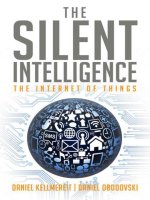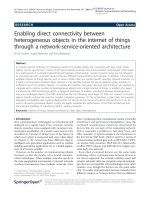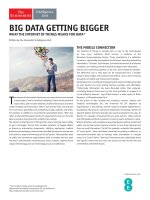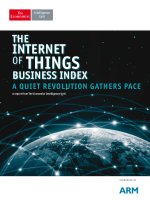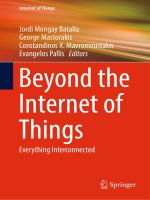Privacy and the internet of things
Bạn đang xem bản rút gọn của tài liệu. Xem và tải ngay bản đầy đủ của tài liệu tại đây (2.59 MB, 74 trang )
O’Reilly IoT
Privacy and the Internet of
Things
Gilad Rosner
Privacy and the Internet of Things
by Gilad Rosner
Copyright © 2017 O’Reilly Media, Inc. All rights reserved.
Printed in the United States of America.
Published by O’Reilly Media, Inc., 1005 Gravenstein Highway North,
Sebastopol, CA 95472.
O’Reilly books may be purchased for educational, business, or sales
promotional use. Online editions are also available for most titles
(). For more information, contact our
corporate/institutional sales department: 800-998-9938 or
Editors: Susan Conant and Jeff Bleiel
Production Editor: Shiny Kalapurakkel
Copyeditor: Octal Publishing, Inc.
Proofreader: Charles Roumeliotis
Interior Designer: David Futato
Cover Designer: Randy Comer
Illustrator: Rebecca Panzer
October 2016: First Edition
Revision History for the First Edition
2016-10-05: First Release
The O’Reilly logo is a registered trademark of O’Reilly Media, Inc. Privacy
and the Internet of Things, the cover image, and related trade dress are
trademarks of O’Reilly Media, Inc.
While the publisher and the author have used good faith efforts to ensure that
the information and instructions contained in this work are accurate, the
publisher and the author disclaim all responsibility for errors or omissions,
including without limitation responsibility for damages resulting from the use
of or reliance on this work. Use of the information and instructions contained
in this work is at your own risk. If any code samples or other technology this
work contains or describes is subject to open source licenses or the
intellectual property rights of others, it is your responsibility to ensure that
your use thereof complies with such licenses and/or rights.
978-1-491-93282-7
[LSI]
Introduction
The “Internet of Things,” or IoT, is the latest term to describe the
evolutionary trend of devices becoming “smarter”: more aware of their
environment, more computationally powerful, more able to react to context,
and more communicative. There are many reports, articles, and books on the
technical and economic potential of the IoT, but in-depth explorations of its
privacy challenges for a general audience are limited. This report addresses
that gap by surveying privacy concepts, values, and methods so as to place
the IoT in a wider social and policy context.
How many devices in your home are connected to the Internet? How about
devices on your person? How many microphones are in listening distance?
How many cameras can see you? To whom is your car revealing your
location? As the future occurs all around us and technology advances in scale
and scope, the answers to these questions will change and grow. Vint Cerf,
described as one of the “fathers of the Internet” and chief Internet evangelist
for Google, said in 2014, “Continuous monitoring is likely to be a powerful
element in our lives.”1 Indeed, monitoring of the human environment by
powerful actors may be a core characteristic of modern society.
Regarding the IoT, a narrative of “promise or peril” has emerged in the
popular press, academic journals, and in policy-making discourse.2 This
narrative focuses on either the tremendous opportunity for these new
technologies to improve humanity, or the terrible potential for them to
destroy what remains of privacy. This is quite unhelpful, fueling alarmism
and hindering thoughtful discussion about what role these new technologies
play. As with all new technical and social developments, the IoT is a
multilayered phenomenon with valuable, harmful, and neutral properties. The
IoT is evolutionary not revolutionary; and as with many technologies of the
information age, it can have a direct effect on people’s privacy. This report
examines what’s at stake and the frameworks emerging to address IoT
privacy risks to help businesses, policy-makers, funders, and the public
engage in constructive dialogue.
What This Report Is and Is Not About
This report does the following:
Draws together definitions of the IoT
Explores what is meant by “privacy” and surveys its mechanics and
methods from American and European perspectives
Briefly explains the differences between privacy and security in the IoT
Examines major privacy risks implied by connected devices in the
human environment
Reviews existing and emerging frameworks to address these privacy
risks
Provides a foundation for further reading and research into IoT privacy
This report is not about:
Trust — in the sense of people’s comfort with and confidence in the IoT
The potential benefits or values of the IoT — this is covered
exhaustively in other places3
The “industrial IoT” — technologies that function in industrial contexts
rather than consumer ones (though the boundary between those two
might be fuzzier than we like to think4)
Issues of fully autonomous device behavior — for example, self-driving
cars and their particular challenges
We can divide IoT privacy challenges into three categories:
IoT privacy problems as classic, historical privacy problems
IoT privacy problems as Big Data problems
IoT privacy problems relating to the specific technologies,
characteristics, and market sectors of connected devices
This report examines this division but mainly focuses on the third category:
privacy challenges particular to connected devices and the specific
governance they imply.
Discussions of privacy can sometimes be too general to be impactful. Worse,
there is a danger for them to be shrill: the “peril” part of the “promise or
peril” narrative. This report attempts to avoid both of these pitfalls. In 1967,
Alan Westin, a central figure in American privacy scholarship, succinctly
described a way to treat emergent privacy risks:
The real need is to move from public awareness of the problem to a
sensitive discussion of what can be done to protect privacy in an age when
so many forces of science, technology, environment, and society press
against it from all sides.5
Historically, large technological changes have been accompanied by social
discussions about privacy and vulnerability. In the 1960s, the advent of
databases and their use by governments spurred a far-ranging debate about
their potential for social harms such as an appetite for limitless collection and
impersonal machine-based choices about people’s lives. The birth of the
commercial Internet in the 1990s prompted further dialogue. Now, in this
“next wave” of technology development, a collective sense of vulnerability
and an awareness that our methods for protecting privacy might be out of step
propel these conversations forward. It’s an excellent time to stop, reflect, and
discuss.
1
Anderson, J. and Ranie, L. 2014. The Internet of Things Will Thrive by 2025: The Gurus Speak.
Pew Research Center. Available at />
2
For example, see Howard, P. 2015. Pax Technica: How the Internet of Things May Set Us Free or
Lock Us Up. New Haven: Yale University Press; Cunningham, M. 2014. Next Generation Privacy:
The Internet of Things, Data Exhaust, and Reforming Regulation by Risk of Harm. Groningen
Journal of International Law, 2(2):115-144; Bradbury, D. 2015. How can privacy survive in the era
of the internet of things? The Guardian. Available at Opening Statement of
the Hon. Michael C. Burgess, Subcommittee on Commerce, Manufacturing, and Trade Hearing on
“The Internet of Things: Exploring the Next Technology Frontier,” March 24, 2015. Available at
/>
3
3
E.g., see Manyika, J. et. al. 2015. Unlocking the Potential of the Internet of Things. Available at
UK Government Office for Science. 2014. The Internet of Things: making the
most of the Second Digital Revolution. Available at O’Reilly, T. and
Doctorow, C. 2015. Opportunities and Challenges in the IoT. Sebastopol: O’Reilly Media.
4
For example, the US National Security Telecommunications Advisory Committee Report to the
President on the Internet of Things observes, “the IoT’s broad proliferation into the consumer
domain and its penetration into traditionally separate industrial environments will progress in
parallel and become inseparable.” See />
5
Westin, A. 1967. Privacy and Freedom. New York: Atheneum.
What Is the IoT?
So, what is the IoT? There’s no single agreed-upon definition, but the term
goes back to at least 1999, when Kevin Ashton, then-director of the Auto-ID
Center at MIT, coined the phrase.6 However, the idea of networked
noncomputer devices far predates Ashton’s term. In the late 1970s, caffeinefixated computer programmers at Carnegie Mellon University connected the
local Coca Cola machine to the Arpanet, the predecessor to the Internet.7 In
the decades since, several overlapping concepts emerged to describe a world
of devices that talk among themselves, quietly, monitoring machines and
human beings alike: ambient intelligence, contextual computing, ubiquitous
computing, machine-to-machine (M2M), and most recently, cyber-physical
systems.
The IoT encompasses several converging trends, such as widespread and
inexpensive telecommunications and local network access, cheap sensors and
computing power, miniaturization, location positioning technology (like
GPS), inexpensive prototyping, and the ubiquity of smartphones as a
platform for device interfaces. The US National Security
Telecommunications Advisory Committee wrote in late 2014:8 “the IoT
differs from previous technological advances because it has surpassed the
confines of computer networks and is connecting directly to the physical
world.”
One term that seems interchangeable with the IoT is connected devices,
because the focus is on purpose-built devices rather than more generic
computers. Your laptop, your desktop, and even your phone are generic
computing platforms — they can do many, many things, most of which were
not imagined by their original creators. “Devices” in this sense refers to
objects that are not intended to be full-fledged computers. Fitness and
medical wearables, cars, drones, televisions, and toys are built for a relatively
narrow set of functions. Certainly, they have computing power — and this
will only increase over time — but they are “Things” first and computers
second.
As to the size of the IoT, there are many numbers thrown around, a popular
one being Cisco’s assertion that there will be 50 billion devices on the ‘net in
2020.9 This is a guess — one of several, as shown in Figure 2-1.
Figure 2-1. Industry estimates for connected devices (billions) in 2020 (source: The Internet of Things:
making the most of the Second Digital Revolution, UK Government Office for Science, 2014)
Segmenting the IoT into categories, industries, verticals, or technologies
assists in examining its privacy risks. One categorization is consumer versus
industrial applications, for example, products in the home versus oil and gas
drilling. Separating into categories can at least make a coarse division
between technologies that deal directly in personal data (when are you home,
who is in the home, what are you watching or eating or saying) and those that
do not. For privacy analysis, it’s also valuable to separate the IoT into
product sectors, like wearables, medical/health/fitness devices, consumer
goods, and the connected car. Similarly useful are verticals like cities, health,
home, and transport. The smart city context, for example, implicates different
privacy, governance, and technology issues than the health context.
The IoT is a banner for a variety of definitions, descriptions, technologies,
contexts, and trends. It’s imprecise and messy, but a few key characteristics
emerge: sensing, networking, data gathering on humans and their
environment, bridging the physical world with the electronic one, and
unobtrusiveness. And although the concept of connected devices is decades
old, policy-makers, journalists, and the public are tuning in to the topic now
because these devices are noticeably beginning to proliferate and encroach
upon personal spaces in ways that staid desktops and laptops did not.
Ultimately, the term will vanish, like “mobile computing” did, as the fusion
of networking, computation, and sensing with formerly deaf and dumb
objects becomes commonplace and unremarkable.
6
Ashton, K. 2009. That “Internet of Things” Thing. RFID Journal. Available at
/>
7
The “Only” Coke Machine on the Internet. Available at
/>
8
See footnote 4.
9
Evans, D. 2011. The Internet of Things: How the Next Evolution of the Internet Is Changing
Everything. Available at />
What Do We Mean by Privacy?
Much like the problem of saying “the Internet of Things” and then assuming
that everyone knows what you are talking about, the term “privacy” means
very different things to people. This is as true among experts, practitioners,
and scholars as it is among general society. “Privacy is a concept in disarray,”
observes Dan Solove, one of America’s leading privacy law scholars; it is
“too complicated a concept to be boiled down to a single essence.”10 Privacy
is an economic, political, legal, social, and cultural phenomenon, and is
particular to countries, regions, societies, cultures, and legal traditions. This
report briefly surveys American and European privacy ideas and
mechanisms.
The Concept of Privacy in America and Europe
In 1890, two American legal theorists, Warren and Brandeis, conceived of
the “right to be let alone” as a critical civil principle,11 a right to be protected.
This begins the privacy legal discussion in the United States and is often
referenced in European discussions of privacy, as well. Later, in 1967,
privacy scholar Alan Westin identified “four basic states of privacy”:
Solitude
Physical separation from others
Intimacy
A “close, relaxed, and frank relationship between two or more
individuals” that can arise from seclusion
Anonymity
Freedom from identification and surveillance in public places
Reserve
“The creation of a psychological barrier against unwanted intrusion”12
Westin wrote that privacy is “the claim of individuals, groups, or institutions
to determine for themselves when, how, and to what extent information about
them is communicated to others.”13 This view appears also in European
conceptions of privacy. In 1983, a German Constitutional Court articulated a
“right of informational self-determination,” which included “the authority of
the individual to decide [for] himself...when and within what limits
information about his private life should be communicated to others.”14 In
Europe, privacy is conceived as a “fundamental right” that people are born
with. European policies mainly use the term “data protection” rather than
“privacy.” It’s a narrower concept, applied specifically to policies and rights
that relate to organizations’ fair treatment of personal data and to good data
governance. Privacy covers a broader array of topic areas and is concerned
with interests beyond fairness, such as dignity, inappropriate surveillance,
intrusions by the press, and others.
In 1960, American law scholar William Prosser distilled four types of
harmful activities that privacy rights addressed:
Intrusion upon someone’s seclusion or solitude, or into her private
affairs
Public disclosure of embarrassing private facts
Publicity which places someone in a false light
Appropriation of someone’s name or likeness for gain without her
permission15
This conception of privacy is, by design, focused on harms that can befall
someone, thereby giving courts a basis from which to redress them. But, as
the preceding descriptions show, conceiving of privacy exclusively from the
perspective of harms is too narrow.
Thinking of privacy harms tends to focus discussion on individuals. Privacy,
however, must also be discussed in terms of society. Privacy and data
protection, it is argued, are vital for the functioning of society and
democracy. Two German academics, Hornung and Schnabel, assert:
...data protection is... a precondition for citizens’ unbiased participation in
the political processes of the democratic constitutional state. [T]he right to
informational self-determination is not only granted for the sake of the
individual, but also in the interest of the public, to guarantee a free and
democratic communication order.16
Similarly, Israeli law scholar Ruth Gavison wrote in 1980: “Privacy
is...essential to democratic government because it fosters and encourages the
moral autonomy of the citizen, a central requirement of a democracy.”17
In this way, privacy is “constitutive” of society,18 integrally tied to its health.
Put another way, privacy laws can be seen as social policy, encouraging
beneficial societal qualities and discouraging harmful ones.19
In trying to synthesize all of these views, Professor Solove created a
taxonomy of privacy that yields four groups of potentially harmful
activities:20
Information collection
Surveillance: watching, listening to, or recording an individual’s
activities
Interrogation: questioning or probing for information
Information processing
Aggregation: combining various pieces of data about a person
Identification: linking information to particular individuals
Insecurity: carelessness in protecting stored information
Secondary use: use of information for a purpose other than what it was
originally collected for without a person’s consent
Exclusion: failure to allow someone to know about data others have
about him, and to participate in its handling and use
Information dissemination
Breach of confidentiality: breaking a promise to keep a person’s
information confidential
Disclosure: revelation of information that affects how others judge
someone
Exposure: revealing another’s nudity, grief, or bodily functions
Increased accessibility: amplifying the accessibility of information
Blackmail: the threat to disclose personal information
Appropriation: the use of someone’s identity to serve someone else’s
interests
Distortion: disseminating false or misleading information about
someone
Invasion
Intrusion: invading someone’s tranquillity or solitude
Decisional interference: incursion into someone’s decisions regarding
her private affairs
Although this taxonomy is focused around the individual, it should be
understood that personal losses of privacy add up to societal harms. One of
these is commonly called chilling effects: if people feel like they are being
surveilled, or that what they imagine to be private, intimate conversations or
expressions are being monitored, recorded, or disseminated, they are less
likely to say things that could be seen as deviating from established norms.21
This homogenization of speech and thought is contrary to liberty and
democratic discourse, which relies upon a diversity of views. Dissent,
unpopular opinions, and intellectual conflict are essential components of
free societies — privacy helps to protect them.
One important thing to take away from this discussion is that there is no neat
split between information people think of as public versus information that is
private. In part, this is because there is no easy definition of either. Consider
medical information shared with your doctor — it will travel through various
systems and hands before its journey is complete. Nurses, pharmacists,
insurance companies, labs, and administrative staff will all see information
that many citizens deem private and intimate. Here again we see the problem
of construing privacy as secrecy. Information is shared among many people
within a given context. One theory22 within privacy scholarship says that
when information crosses from one context into another — for example,
medical information falling into nonmedical contexts, such as employment
— people experience it as a privacy violation (see the section “Breakdown of
Informational Contexts” later in this report). Advances in technology further
complicate notions of the public and the private, and cause us to reflect more
on where, when, and what is deserving of privacy protections.
It’s worth noting that the public/private split in American privacy regimes is
different than the European conception of data protection, which focuses on
restricting the flow of personal data rather than private or confidential data.
The recently enacted General Data Protection Regulation defines personal
data as:
any information relating to an identified or identifiable natural person...; an
identifiable natural person is one who can be identified, directly or
indirectly, in particular by reference to an identifier such as a name, an
identification number, location data, an online identifier or to one or more
factors specific to the physical, physiological, genetic, mental, economic,
cultural or social identity of that natural person23
Much ink has been spilled in comparing the US and European approaches,24
but suffice it to say that there are pros and cons to each. They yield different
outcomes, and there is much to be gained from drawing upon the best
elements of both.25
It’s essential to remember that privacy costs money. That is, building
information systems that incorporate strong security, user preferences,
encryption, and privacy-preserving architectures requires investments of
capital, time, and know-how — all things that organizations seek to
maximize and conserve. It means that, when making devices and services,
the preservation of privacy can never be divorced from economic
considerations. Businesses must have a reason — an economic justification
— for incorporating privacy into their designs: regulatory requirements,
product/service differentiation, voluntary adherence to best practices,
contractual obligation, and fear of brand damage among other reasons. There
is also a view that managers, developers, engineers, and executives include
privacy in their products because it is the right thing to do — that good
stewardship of personal data is a social value worth embedding in
technology. Recent research by Berkeley professors Kenneth Bamberger and
Deirdre Mulligan, however, illustrates that the right thing might be driven by
business perceptions of consumer expectations.26 Often, there is no easy
separation of the economic and social reasons privacy architectures are built
into technology, but the point is, from an engineering or compliance
perspective, someone must pay for privacy.
Privacy is not just the law nor just rules to protect data sharing and storage;
it’s a shifting conversation about values and norms regarding the flow of
information. Laws and rules enact the values and norms we prize, but they
are “carriers” of these ideas. This means, however, that the current picture
of privacy rules is not the only way to protect it. The topic of the IoT
affords an opportunity to reflect. How things have been need not be how they
will be going forward. Research shows that people are feeling vulnerable and
exposed from the introduction of new Internet technologies.27 As a wave of
new devices are entering our intimate spaces, now is an excellent time to
review the institutional and technical ways privacy is protected, its
underlying values, and what can be done differently.
WHAT’S THE RELATIONSHIP BETWEEN PRIVACY AND SECURITY?
Sometimes, the domains of privacy and security can be conflated, but they are not the same thing.
They overlap, and, technologically, privacy is reliant on security, but they are separate topics.
Here’s how one US federal law defines information security:28
protecting information and information systems from unauthorized access, use, disclosure,
disruption, modification, or destruction in order to provide
(A) integrity — guarding against improper modification or destruction of data
(B) confidentiality — ensuring only the correct authorized party gets access to systems
(C) availability — making sure the system can be accessed when called for
Whereas one of these — confidentiality — has a direct relationship with privacy, security is
concerned with making sure a system does what it’s designed to do, and can be affected only by
the appropriate, authorized people. Compare this to the preceding discussion about privacy;
security covers a much narrower set of concerns. A good example is the news from 2015 that
hackers were able to access the Bluetooth connection of a sound system in Jeep vehicles to
remotely shut off the engine and trigger the brakes while it was driving.29 This is a security
concern. Wondering about who gets to see all the data that a Jeep’s black box captures, where the
car has been, and who was present in the vehicle are privacy concerns — they relate to
information flows, exposure, and identifiability.
10Solove,
D. 2006. A Taxonomy of Privacy. University of Pennsylvania Law Review 154(3):477-560.
Available at />
11Brandeis,
L. and Warren, S. 1890. The Right to Privacy. Harvard Law Review 4(5):193-220.
Available at />
12See
footnote 5.
13See
footnote 5.
14Quoted
in Rouvroy, A. and Poullet, Y. 2009. The Right to Informational Self-Determination and
the Value of Self-Development: Reassessing the Importance of Privacy for Democracy. In S.
Gutwirth, Y. Poullet, P. De Hert, C. de Terwangne, & S. Nouwt (eds.), Reinventing Data
Protection? (pp. 45-76). Dordrecht: Springer.
15Prosser,
W. 1960. Privacy. California Law Review 48(3):383-423. Available at
/>
16Hornung,
G. and Schnabel, C. 2009. Data Protection in Germany I: The Population Census
Decision and the Right to Informational Self-Determination. Computer Law & Security Report
25(1): 84-88.
17Gavison,
R. 1980. Privacy and the Limits of the Law. Yale Law Journal 89(3):421-471. Available
at />
18Schwartz,
P. 2000. Internet Privacy and the State. Connecticut Law Review 32(3):815-860.
Available at Simitis, S. 1987. Reviewing Privacy in an Information Society.
University of Pennsylvania Law Review 135(3):707-746. Available at />
19See
Part 1 of Bennett, C. and Raab, C. 2003. The Governance of Privacy: Policy Instruments in
Global Perspective. Burlington: Ashgate Publishing.
20See
footnote 10.
21For
example, recent research has documented how traffic to Wikipedia articles on privacy-sensitive
subjects decreased in the wake of the Snowden NSA revelations: />
22Nissenbaum,
23General
H. 2010. Privacy in Context. Stanford: Stanford University Press.
Data Protection Regulation, Article 4(1). Available at />
24See,
e.g., Part 1 of Schwartz, P. 2008. Preemption and Privacy. Yale Law Journal 118(5):902-947.
Available at Reidenberg, J. (1999). Resolving Conflicting International Data
Privacy Rules in Cyberspace. Stanford Law Review 52(5):1315-71. Available at
Sec. 4.6 of Waldo, J., Lin, H., and Millet, L. 2007. Engaging Privacy and
Information Technology in a Digital Age. Washington, D.C.: The National Academies Press.
Available at />
25Rosner,
G. 2015. There is room for global thinking in IoT data privacy matters. O’Reilly Media.
Available at />
26Bamberger,
K. and Mulligan, D. 2015. Privacy on the Ground: Driving Corporate Behavior in the
United States and Europe. Cambridge: MIT Press.
27E.g.,
see the Pew Research Center’s “The state of privacy in post-Snowden America: What we
learned,” available at and findings from the EU-funded CONSENT
project, “What consumers think,” available at />
2844
US Code § 3542.
29Greenberg,
A. 2015. Hackers Remotely Kill a Jeep on the Highway–With Me in It. Wired, 21 July.
Available at />
Privacy Risks of the IoT
Now that we’ve reviewed some definitions of the IoT and explored the
concept of privacy, let’s examine some specifics more closely. This section
identifies six privacy risks suggested by the increasing number of networked,
sensing devices in the human environment.
Enhanced Monitoring
The chief privacy risk implied by a world of sensing, connected devices is
greater monitoring of human activity. Context awareness through
enhanced audio, video, location data, and other forms of detection is touted as
a central value of the IoT. No doubt, important and helpful new services will
be enabled by such detection, but the privacy implication is clear: you will be
under observation by your machines and devices you do not control.
Certainly, this exists in the world today — public CCTV, private security
cameras, MAC address detection, location data capture from phones,
Bluetooth beacons, license plate readers... the list is quite long, and growing.
The human world is highly monitored so the issue becomes one of scale.
Perhaps such monitoring is a condition of modern life; that observation by
both the state and the private sector are core features of the social landscape.30
This, then, is a central reason why “the right to be let alone” is a prominent
value within privacy discourse.
When American lawyers Warren and Brandeis proposed this right in 1890, it
was in response to the appearance of a new technology — photography
(Figure 4-1). They saw the potential for photography to intrude upon private
spaces and broadcast what was captured to ever-widening audiences through
newspapers.31
Figure 4-1. The privacy scourge of the 19th century: an early Kodak camera
The discussion of privacy and the IoT is no different: it is not the Internet of
Things that raises hackles — it is the Intimacy of Things. Warren and
Brandeis worried about photographers snapping pictures through bedroom
windows. A modern version of this is the bathroom scale and your Fitbit
broadcasting your weight and (lack of) exercise discipline to an audience
larger than you intended.
Another touted feature of the coming wave of devices is their invisibility or
unobtrusiveness. Here again is tension between an attractive design
characteristic and social norms of privacy. If monitoring devices fade out of
view, you might not know when you’re being watched.
A direct result of enhanced monitoring is greater ease in tracking people’s
movements. That is, more devices — and therefore more organizations and
systems — will know where you are, where you’ve been, and, increasingly,
where you’re going next.32 Location privacy has been eroding for many years

